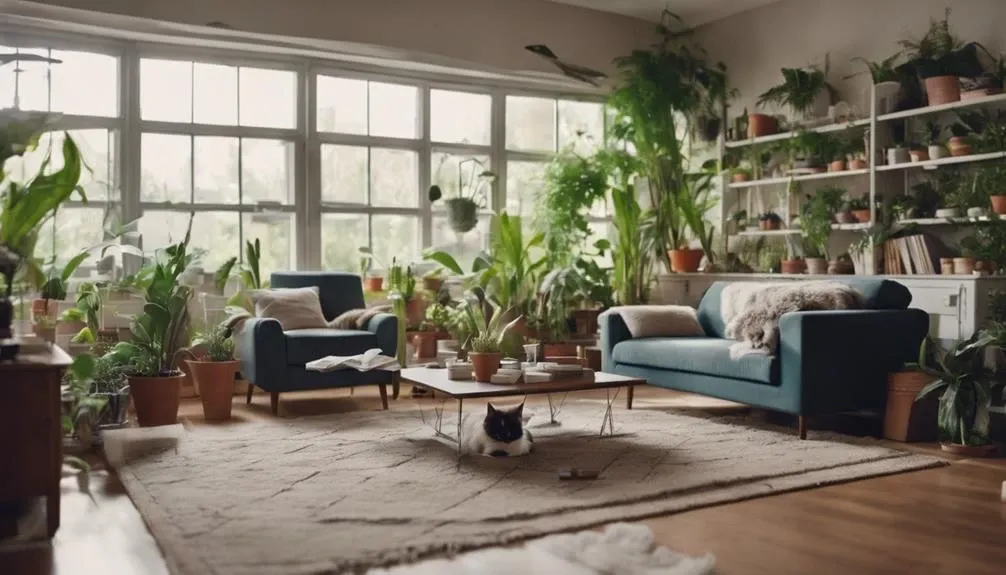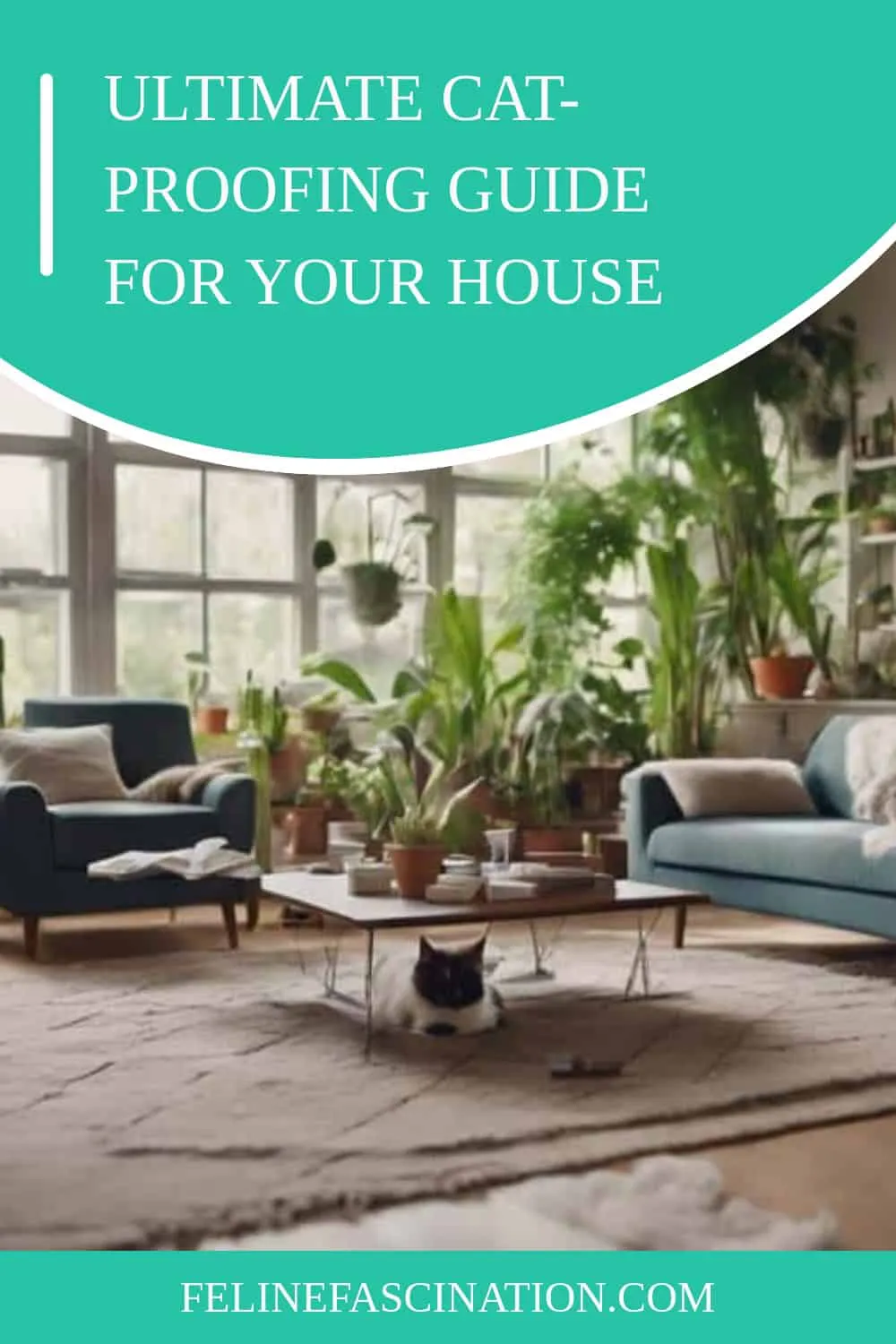The Best Fluffy Pancakes recipe you will fall in love with. Full of tips and tricks to help you make the best pancakes.

When it comes to creating a safe haven for your curious feline friend, the task of cat-proofing your house can seem like an endless maze of potential hazards.
But fear not, as we unveil practical solutions and ingenious tricks to safeguard every nook and cranny of your home from whiskered intruders.
From innovative furniture covers to strategic placement of plants, this guide will equip you with the knowledge and tools necessary to protect your beloved pet and maintain your sanity in the process.
Key Takeaways
- Secure toxic items and hazards out of reach in every room.
- Utilize cat-proofing tools like cord protectors and furniture covers.
- Incorporate safe plants and furniture for a feline-friendly environment.
- Implement safety precautions such as childproof locks on cabinets with harmful substances.
Living Room Cat-Proofing
When cat-proofing your living room, always place poisonous plants out of reach to prevent accidental ingestion by your feline friends. Cats are curious creatures and may nibble on plants, so it's crucial to keep them safe from toxic ones like lilies or philodendrons.
Additionally, make sure to secure electrical cords and cover them to prevent chewing hazards. Cats can get tangled in blind cords, so it's wise to secure them or cut them to avoid entanglement risks.
Consider providing scratching posts to satisfy your cat's natural urge to scratch and protect your furniture. Cat-proof window screens are essential to prevent cats from accidentally falling out of windows.
Store cleaning supplies in cabinets with child-proof locks to avoid accidental poisoning. Always consult your vet before introducing new plants to ensure they're safe for your beloved feline companion.
Bedroom Cat-Proofing
When cat-proofing your bedroom, remember to hide cords safely to prevent your cat from chewing on them and potentially getting injured.
Make sure to secure wardrobe doors to avoid any mishaps or accidental cat traps.
Keeping these points in mind will help create a safe and cat-friendly environment in your bedroom.
Hide Cords Safely
To ensure a cat-friendly environment in your bedroom, consider utilizing cord protectors or cable management solutions to hide cords safely. Cats are naturally curious and may be tempted to chew on cords, posing a risk to both your pet and your electronics. By securing cords behind furniture or using cord clips, you can prevent your feline friend from accessing them. Additionally, keeping electrical cords out of reach or enclosed in protective tubing can help avoid accidents. Cord covers, cord channels, or cord management boxes are effective ways to organize and conceal cords in your bedroom. Prioritizing cord safety not only protects your possessions but also ensures a safe environment for your beloved cat.
| Cord Protection Methods | Description | Benefits |
|---|---|---|
| Cord Protectors | Safely cover cords | Prevent chewing and damage |
| Cord Clips | Secure cords in place | Keep cords out of reach |
| Protective Tubing | Enclose cords safely | Avoid accidents and damage |
| Cord Covers | Hide cords effectively | Blend with room decor |
| Cord Management Boxes | Organize cords neatly | Conceal multiple cords efficiently |
Secure Wardrobe Doors
To keep your bedroom cat-proof, ensure that you secure wardrobe doors to prevent your feline friend from accessing potential hazards or items stored inside. Here are some tips to help you maintain a safe environment for your curious pet:
- Use childproof locks or latches on wardrobe doors.
- Store items like jewelry, small accessories, or delicate garments out of reach.
- Consider installing sliding doors or doors with secure hinges.
- Keep wardrobe doors closed at all times.
Kitchen Cat-Proofing
Ensure your kitchen is safe for your feline friend by implementing these practical cat-proofing measures. Keep pantry doors closed to prevent access to items toxic to cats like chocolate, raisins, and certain houseplants. Secure trash cans with lids to avoid your cat consuming harmful substances or small items that could cause choking. Store rubber bands, plastic bags, and other hazardous items out of reach.
Wipe down kitchen counters to remove any traces of human food that may be toxic to cats. Additionally, be cautious with stovetops to prevent burns or fires; consider using covers when not in use. Remember to store medications in cabinets with childproof latches to prevent accidental ingestion.
Bathroom Cat-Proofing
When considering cat-proofing your bathroom, remember to store dental floss, string, rubber bands, and hair ties in closed cabinets to prevent choking hazards for your feline friend. Checking plants for toxicity is crucial to avoid poisoning risks, so ensure they're out of reach.
Opt for non-toxic cleaning products and securely store them to prevent accidental ingestion by curious cats. Keeping the toilet lid closed is essential to prevent cats from drinking harmful chemicals or bacteria from the water.
Additionally, store medications and personal care items in cabinets with secure latches to avoid accidental ingestion by your pets. Taking these precautions will help create a safer environment for your cat in the bathroom.
- Store dental floss, string, rubber bands, and hair ties in closed cabinets
- Check plants for toxicity and keep them out of reach
- Use non-toxic cleaning products and store them securely
- Keep the toilet lid closed to prevent access to harmful substances
Laundry Room Cat-Proofing
For a cat-proof laundry room, always keep the washing machine and dryer closed when not in use to prevent curious felines from climbing inside. Cats are naturally drawn to cozy spaces, and the warm, enclosed environment of appliances can be irresistible to them. Additionally, make sure to store all chemicals such as detergents and fabric softeners out of reach to avoid accidental ingestion by your pets. Before using appliances like the washer or dryer, it's essential to check for any hidden cats inside to prevent accidents.
To further cat-proof your laundry room, use pet-safe ice melters to ensure your cat's safety in case they come into contact with the substances. Secure cords and hoses associated with appliances to prevent cats from chewing on them, which could lead to electrical hazards or damage to the cords. By taking these precautions, you can create a safe and enjoyable laundry room environment for both you and your feline companions.
Balcony Cat-Proofing
To keep your feline friend safe and secure on your balcony, consider implementing various cat-proofing measures to prevent accidents and ensure a worry-free outdoor experience. Here are some practical tips for balcony cat-proofing:
- Use netting or mesh on balcony railings to prevent slipping and falling accidents.
- Install plexiglass or polycarbonate panels as transparent barriers to ensure cat safety.
- Consider creating a catio for a secure outdoor space for your cat to enjoy.
- Use fence toppers or roller bars to prevent cats from climbing and potentially falling.
Additionally, provide shelter and shade on the balcony to protect your cat from extreme weather conditions. By incorporating these measures, you can create a safe and enjoyable outdoor environment for your furry companion.
Yard/Garden Cat-Proofing
Ensuring the safety of your cat in the yard and garden involves proactive measures to prevent exposure to harmful substances and plants. Keep toxic chemicals like antifreeze, motor oil, and windshield fluid out of reach to prevent poisoning. If there are any spills, especially of antifreeze, clean them up immediately as they can be toxic to cats.
It's essential to avoid using commercial ant and roach poison in the yard/garden to prevent accidental ingestion by cats. When bringing new plants home for the garden, always consult a vet to ensure they're safe for your feline friend.
Store hazardous items such as pesticides and fertilizers in a secure location to prevent any exposure to cats. By taking these precautions, you can create a safe outdoor environment for your beloved cat to enjoy without any risks from poisonous plants or harmful substances.
Essential Cat-Proofing Tools
To ensure a cat-friendly environment at home, essential cat-proofing tools like furniture covers and scratch deterrents can help protect your belongings from scratches and cat hair.
Pet-resistant window screens and balcony enclosures with cat-safe netting are crucial for keeping your furry friend safe while enjoying the outdoors.
Cord protectors and cable management solutions can also prevent cats from chewing on cords and causing potential electrical hazards.
Cat-Friendly Furniture
When selecting furniture for your home with a cat in mind, prioritize sturdy, scratch-resistant materials to prevent damage and provide a safe environment for your feline friend. Make your space cat-friendly with these tips:
- Choose furniture with washable covers for easy cleaning.
- Opt for pieces without small gaps to avoid potential cat injuries.
- Provide high perches and vertical climbing opportunities.
- Set up designated scratching areas like scratching posts or cat trees to deter cats from damaging other furniture.
Safe Plants for Cats
Opt for incorporating cat-safe plants like spider plants and catnip into your home environment to provide enrichment for your feline companion while ensuring their safety.
These safe plants, such as Boston ferns and African violets, are non-toxic and cat-friendly, offering a lush and safe atmosphere for your pet.
Avoid toxic plants like lilies, aloe vera, and philodendrons that can pose health risks if ingested by your cat.
Instead, consider cat-friendly herbs such as cat thyme, cat grass, and catmint to add to your indoor garden.
Researching plant toxicity and seeking veterinarian consultation can help you create a secure space for your beloved feline friend.
Frequently Asked Questions
How Do I Cat Proof My House?
To cat-proof your house, secure window screens, anchor furniture, use plant deterrents, manage electrical cords, keep counters clear, choose safe houseplants, and provide plenty of cat toys. Create a safe haven for your feline friend.
How Can I Make My House More Cat Friendly?
To make your house more cat-friendly, incorporate cat-friendly furniture, interactive toys, elevated perches, scratch posts, hidden litterboxes, window perches, and safe plants. Create a space that meets your cat's needs while keeping them happy and engaged.
How Do I Cat Proof My Laundry Room?
To cat-proof your laundry room, secure appliances, hide detergents, and use pet gates. Install cat shelves to keep them off appliances. Remove hidden dangers like loose cords. DIY solutions like enclosed litter boxes can help.
How Do I Cat Proof My Bathroom?
Toilet paper, shower curtain, cabinets closed, sinks covered, trash cans, cleaning supplies, and bath mats need attention. Keep these items out of reach or secure them to ensure your cat's safety in the bathroom.
Conclusion
In conclusion, by following the tips and strategies outlined in this guide, you can create a safe and enriching environment for your beloved feline friend.
Remember to always prioritize your cat's well-being and safety by cat-proofing your home and providing essential tools for their care.
With a little effort and attention to detail, you can ensure a happy and healthy life for your cat in your cat-proofed house.










